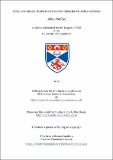Files in this item
Full coverage displays for non-immersive applications
Item metadata
| dc.contributor.advisor | Nacenta, Miguel | |
| dc.contributor.author | Petford, Julian | |
| dc.coverage.spatial | xi, 298 p. | en_US |
| dc.date.accessioned | 2019-04-05T09:51:30Z | |
| dc.date.available | 2019-04-05T09:51:30Z | |
| dc.date.issued | 2019-06-26 | |
| dc.identifier.uri | https://hdl.handle.net/10023/17459 | |
| dc.description.abstract | Full Coverage Displays (FCDs), which cover the interior surface of a room with display pixels, can create novel user interfaces taking advantage of natural aspects of human perception and memory which we make use of in our everyday lives. However, past research has generally focused on FCDs for immersive experiences, the required hardware is generally prohibitively expensive for the average potential user, configuration is complicated for developers and end users, and building applications which conform to the room layout is often difficult. The goals of this thesis are: to create an affordable, easy to use (for developers and end users) FCD toolkit for non-immersive applications; to establish efficient pointing techniques in FCD environments; and to explore suitable ways to direct attention to out-of-view targets in FCDs. In this thesis I initially present and evaluate my own "ASPECTA Toolkit" which was designed to meet the above requirements. Users during the main evaluation were generally positive about their experiences, all completing the task in less than three hours. Further evaluation was carried out through interviews with researchers who used ASPECTA in their own work. These revealed similarly positive results, with feedback from users driving improvements to the toolkit. For my exploration into pointing techniques, Mouse and Ray-Cast approaches were chosen as most appropriate for FCDs. An evaluation showed that the Ray-Cast approach was fastest overall, while a mouse-based approach showed a small advantage in the front hemisphere of the room. For attention redirection I implemented and evaluated a set of four visual techniques. The results suggest that techniques which are static and lead all the way to the target may have an advantage and that the cognitive processing time of a technique is an important consideration. | en_US |
| dc.description.sponsorship | "This work was supported by the EPSRC (grant number EP/L505079/1) and SurfNet (NSERC)." - Acknowledgements | en |
| dc.language.iso | en | en_US |
| dc.publisher | University of St Andrews | |
| dc.rights | Attribution-NonCommercial-ShareAlike 4.0 International | * |
| dc.rights.uri | http://creativecommons.org/licenses/by-nc-sa/4.0/ | * |
| dc.subject | Human-computer interaction | en_US |
| dc.subject | Projection | en_US |
| dc.subject | Pointing | en_US |
| dc.subject | Attention guidance | en_US |
| dc.subject | Full coverage displays | en_US |
| dc.subject | Ray-casting | en_US |
| dc.subject | Mouse pointing | en_US |
| dc.subject.lcc | QA76.9H85P4 | |
| dc.subject.lcsh | Human-computer interaction | en |
| dc.subject.lcsh | Information display systems | en |
| dc.title | Full coverage displays for non-immersive applications | en_US |
| dc.type | Thesis | en_US |
| dc.contributor.sponsor | Engineering and Physical Sciences Research Council (EPSRC) | en_US |
| dc.contributor.sponsor | Engineering and Physical Sciences Research Council (EPSRC) | en |
| dc.contributor.sponsor | SurfNet (NSERC) | |
| dc.type.qualificationlevel | Doctoral | en_US |
| dc.type.qualificationname | PhD Doctor of Philosophy | en_US |
| dc.publisher.institution | The University of St Andrews | en_US |
| dc.identifier.doi | https://doi.org/10.17630/10023-17459 |
The following licence files are associated with this item:
This item appears in the following Collection(s)
Except where otherwise noted within the work, this item's licence for re-use is described as Attribution-NonCommercial-ShareAlike 4.0 International
Items in the St Andrews Research Repository are protected by copyright, with all rights reserved, unless otherwise indicated.


